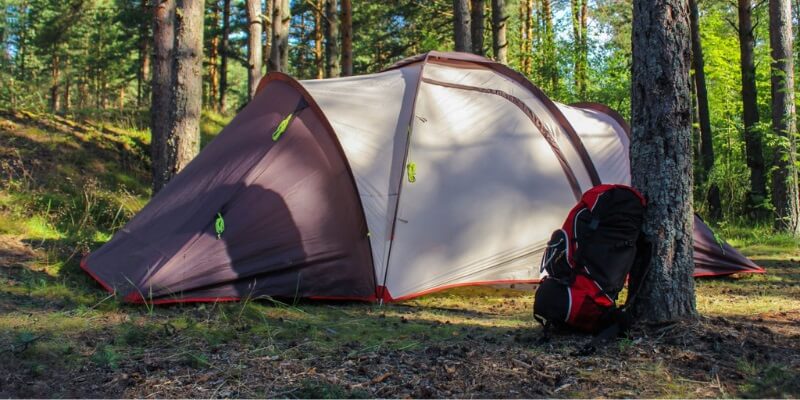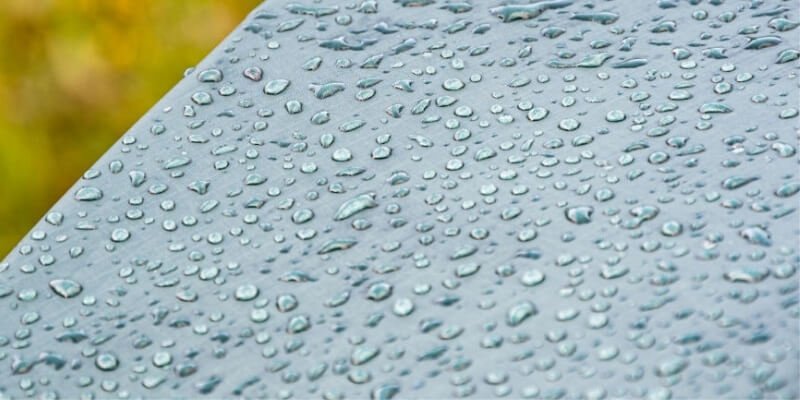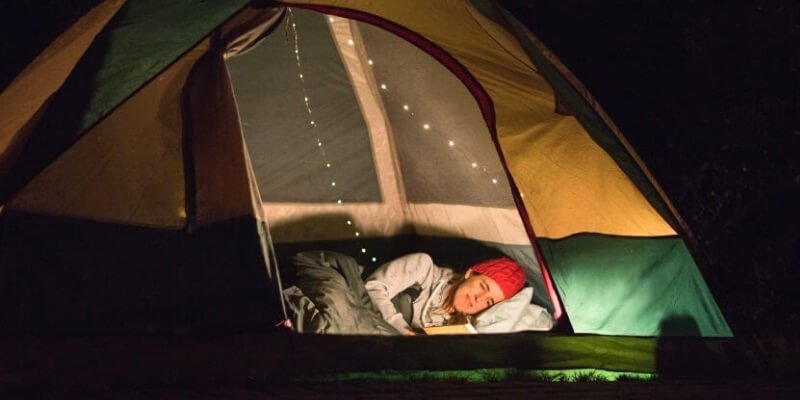How to Clean a Tent in 7 Easy Steps
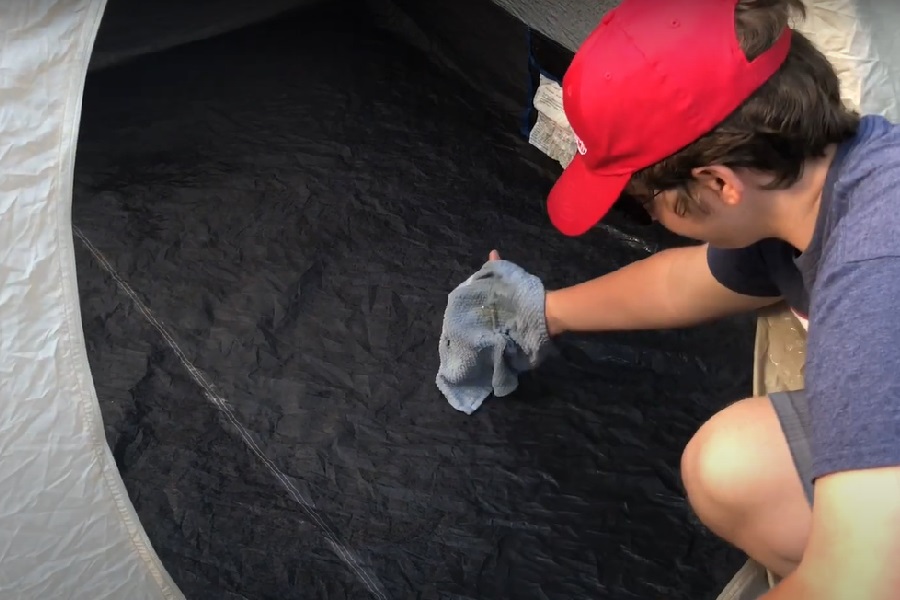
Cleaning a tent is crucial for increasing its serviceability. Regular cleaning helps prevent mold, mildew, and the deterioration of fabric, keeping your tent in top condition for many adventures to come. In this guide, we’ll walk you through step-by-step instructions on how to clean a tent effectively and safely. We cover everything from basic surface cleaning to more intensive stain removal techniques.
How to Clean a Tent (Step by Step)
These are the main steps:
- 1. Get the cloth, tent cleaner, tub, and other accessories
- 2. Shake or vacuum the inner tent
- 3. Put up the tent and wash off the dust
- 4. Selectively clean particularly heavily soiled areas
- 5. Wash the tent in a tub with tent cleaner
- 6. Rinse out the tent with plenty of clean water
- 7. Thoroughly dry the tent
Now let’s see how to clean your tent in detail…
1. Get the Equipment and Materials
First, you will need these tools and materials to clean a dirty tent:
- Cold or lukewarm water
- Fragrance-free detergent (for spot cleaning)
- A detergent for outdoor equipment, such as Nikwax Tech-Wash
- A soft cloth, soft brush, or microfiber wash mitt
- A large tub or bathtub
- Wash-in impregnation for functional textiles, e.g. Nikwax TX.Direct
2. Shake or Vacuum the Inner Tent
A quick way to remove sand and dry grass from your tent is to turn it inside out and shake it. This method is gentle on the tent material because you avoid sweeping or rubbing sand on the tent floor. If any dirt remains, you can use a hand vacuum to clean it once the tent is set up.
3. Put Up the Tent and Wash Off the Dust
The tent walls are easiest to clean when the tent is set up. Use a soft brush to remove dust, dry mud, and salt from the outside. You can also rinse off the dust with a garden hose. This helps stubborn dirt soak and makes it easier to clean. Avoid using a high-pressure cleaner—it may quickly clean the tent, but the pressure can damage the seams!
4. Clean Spots That Are Heavily Soiled
If there are still stains on the inside or outside of the tent, use a soft cloth with lukewarm water and a few drops of fragrance-free dish soap. Rub the stained areas gently, let it sit for a bit, then rinse thoroughly.
For a deeper clean, you can use a tent cleaner like Nikwax Tech Wash, which is highly recommended and has won the Outdoor Industry Award. I’ve had good experiences with Tech Wash on our tents. A microfiber car washing glove works great for cleaning large areas, as it’s soft and gentle on the surface.
If your tent wasn’t too dirty, you’re almost done. Now it’s time to dry the tent. I suggest re-waterproofing it afterward to help keep it cleaner for longer. However, if your tent came back really dirty or you want to do a thorough cleaning, you’ll need to continue with the tent’s fabric. Be careful not to scrub too hard, as the coating on the tent is delicate.
5. Wash the Tent in a Tub with Tent Cleaner
Fill your bathtub or shower tray with lukewarm water and add Nikwax Tech Wash. The bottle says how much tent cleaner to add. Friction, swirling zippers, and heat are not good for your tent. Don’t wash the tent in the washing machine. Open the zippers and turn your tent inside out. Now dip it in the tub. The detergent bottle says how long the tent has to soak.
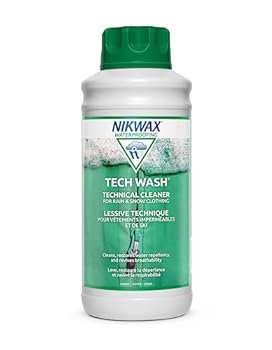
Nikwax Tech Wash
6. Rinse the Tent with Plenty of Clean Water
Now the tent needs a lot of fresh water. Empty the tub, fill it with plain water, and wash the tent with your hands. You may have to repeat this until all the detergents are out of the fabric. Your tent is now really nice and clean and can be dried. If you want, you can impregnate it with Nikwax TX.Direct in the tub beforehand. Then the tent is better equipped for rainy days and repels new dirt more easily.
7. Dry the Tent Thoroughly
Make sure the tent is completely dry. Simply set it up in the garden on a sunny day and open all entrances. If it rains, hang it on a clothesline in the garage or basement. You are done cleaning your tent! Your tent is now clean, waterproof and dry. So you have optimally protected it from new soiling, mold stains and mold.
Clean Zips, Poles and Lines
A tent that’s sparkling clean in all parts makes the best impression. I offer tips for cleaning and protection to help you keep it in top condition.
- Make zips run smoothly
- Clean poles and pegs properly
- Cleaning the tent cords
Make the Zips run smoothly
Take a toothbrush and scrub any mud, sand, and saltwater off your zipper teeth. For stubborn dirt, rinse the zipper with water before and after brushing. To ensure that the zipper continues to run well in the future, care for it with a little silicone spray after scrubbing. Rub the zipper with a thin layer and open and close it a few times – you will feel the difference.
Clean Poles and Pegs
This is especially important if you’ve camped near sand or the sea, as salt can cause metal to rust. To make it easier to assemble the poles, wipe them and the tent pegs with a damp cloth, then apply a thin layer of silicone spray to the metal parts. This will protect the poles and pegs from rust.
Cleaning the Tent Cords
Usually, it is enough to wipe the tent cords with a damp cloth. However, for heavy soiling, put the cords in a cloth bag and wash them in the washing machine. The tent cords must be dried properly after cleaning before you pack them.
Clean Stain on the Tent
Some types of stains require special care or cleaning agents.
Mold, Mold Stains, Algae and Bad Smells
Use an enzyme cleaner to remove mold, mildew, animal urine, and bad odors from your tent. Follow the instructions on the bottle to avoid damaging the tent fabric.
Mold and mildew are among the worst things that happen to a tent. In our test, the stains did not completely disappear when the tent was cleaned with the enzyme cleaner. After all, the bad smell was eliminated. Enzyme cleaners are also highly effective against mold spores. To do something good for your health, treat a moldy tent as quickly as possible.
Candle Wax
The best method is to let the wax cool and then gently scrape it off with a spoon. This works well with a cold spray. If there are still wax residues afterward, you can put blotting paper on the stain and warm the area very carefully With a hairdryer. The blotting paper soaks up the wax.
Bird Droppings
Bird droppings are quite easy to scrape off with a spoon when dry. Then the leftovers are soaked with lukewarm water and a little washing-up liquid and wiped off with a cloth.
Dust, Sand and Mud
You can brush off dried mud, sand, and dust with a soft brush.
Tree Sap
Gently scrape off any dried resin with a spoon. A cold spray makes it easier to scrape off. If the spoon doesn’t completely remove the resin, clean the tent fabric with mineral oil or rubbing alcohol. Then you have to wash the tent well with water. Keep in mind that alcohol attacks the tissue. Just leave it on the tent as long as necessary!
Coffee and Wine Spots
Fresh coffee and wine stains should be wiped immediately with water and a cloth. Rub older, already dried stains with Nikwax Tech Wash and let it sit a little. Then wash the treated areas with plenty of clean water until there are no more soap residues in the fabric.
Fat
Fat is insoluble in water and therefore cannot be removed with water alone. Soak up fresh grease stains as best you can with a tissue or a piece of toilet paper. You can remove grease stains that have already penetrated the fabric with an unscented washing-up liquid or shampoo. Soak the stain with warm water and a little washing-up liquid. After a few minutes of exposure, wash the treated areas with clear water.
Suncream
The UVA filter in sunscreen can cause light or yellowish spots. Since the filter is oil-based, you can clean sunscreen stains on the tent the same way you would remove grease.
FAQs
Can I wash my tent in the washing machine?
If you’re feeling brave, machine washing can save time and effort. From our experience, tents can handle machine washing with the right settings and detergent. However, it’s not as gentle as hand washing. If the seams are stressed or the tent fabric experiences too much friction, your tent could start leaking. Also, cotton tents may shrink if washed in hot water.
How often do I have to clean my tent?
It’s simple: when your tent is dirty! We clean our tents after every major tour. We clean seldom-used tents that are only set up on a few weekends a year at the end of the season.
Which cleaning agents should I not use?
Gentle cleaning agents and special tent cleaners such as Nikwax Tech Wash are ideal for cleaning tents. Please refrain from the following means:
- Scouring milk: Damages the coating through strong friction, and tent windows become dull.
- Fabric softener: The intense smell can attract animals that nibble curiously at your tent.
- Liquid soap: It contains substances that can mold in the tent fabric.
- Power cleaners: Acid or alkaline power cleaners are far too harsh for synthetic fabrics. They destroy the tent’s surface.
When do I have to re-impregnate my tent?
You should re-impregnate your tent whenever you notice a decline in its water resistance. Key indicators include water no longer beading on the surface, which means it’s soaking in instead. We also re-impregnate our tents about every 2 to 3 years at the beginning of the season.
How do I clean my tent windows?
You can clean the tent’s window with a soft microfiber cloth, a little mild detergent, and plenty of water. The detergent must be completely washed off after cleaning. Then dry the windows with a towel to avoid streaks.
How do I properly store my tent after cleaning?
To properly store your tent after cleaning, first ensure it is completely dry to prevent mold and mildew. Set it up in a well-ventilated area or leave it in the sun for a few hours. Once dry, remove any dirt or debris and inspect for damage. Fold the tent neatly to avoid creasing, and store it in a breathable storage bag instead of the stuff sack to allow for air circulation. Finally, place the tent in a cool, dry location, away from direct sunlight and extreme temperatures
The Verdict!
Cleaning your tent is essential for maintaining its longevity and performance. By following these seven easy steps—gathering your supplies, setting up in a suitable area, shaking out debris, spot-cleaning stains, washing the fabric, rinsing thoroughly, and drying properly—you can ensure your tent remains in excellent condition.
Thank you for reading our guide! If you have any questions or suggestions for improvement, please share them in the comments below.


